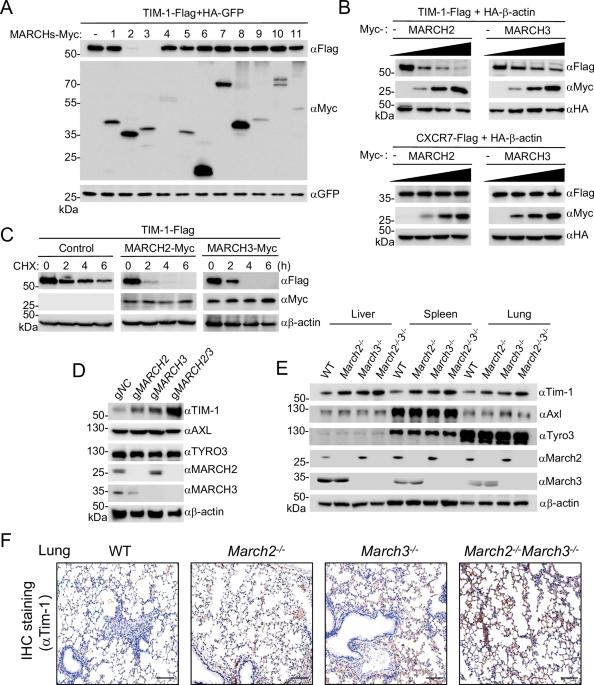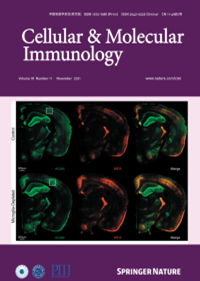膜相关泛素连接酶MARCH2和MARCH3靶向TIM-1以限制寨卡病毒感染。
IF 19.8
1区 医学
Q1 IMMUNOLOGY
引用次数: 0
摘要
t细胞免疫球蛋白粘蛋白家族成员-1 (TIM-1,也称为HAVCR1/KIM-1)是一种跨膜糖蛋白,据报道可作为包括寨卡病毒(ZIKV)在内的多种黄病毒的进入受体。TIM-1的翻译后调控及其对寨卡病毒感染的影响尚不清楚。在本研究中,我们发现膜相关ring - ch型指(MARCH) E3泛素连接酶家族成员MARCH2和MARCH3是生理条件下TIM-1的关键负调控因子。MARCH2和MARCH3与TIM-1结合,分别介导K338和K346位点与k48相关的多泛素化,导致随后的蛋白酶体降解。虽然缺乏MARCH2或MARCH3都会适度增加TIM-1水平并增强ZIKV的传染性,但双敲除MARCH2/3具有更显著的效果。双敲除MARCH2/3增加了野生型细胞的ZIKV传染性,但对TIM-1敲除细胞没有作用,将TIM-1K338R/K346R重组为缺乏TIM-1的细胞比用野生型TIM-1重组提高ZIKV传染性的程度更高。敲除MARCH2或MARCH3均可增加小鼠寨卡病毒的传染性和发病机制,而双敲除MARCH2/3的作用更为显著。这些发现表明,MARCH2和MARCH3靶向TIM-1进行k48相关的多泛素化和蛋白酶体降解,从而作为冗余宿主限制因子限制ZIKV感染和发病机制。本文章由计算机程序翻译,如有差异,请以英文原文为准。

The membrane-associated ubiquitin ligases MARCH2 and MARCH3 target TIM-1 to limit Zika virus infection
T-cell immunoglobulin mucin family member-1 (TIM-1, also known as HAVCR1/KIM-1) is a transmembrane glycoprotein that has been reported to act as an entry receptor for multiple flaviviruses including Zika virus (ZIKV). The post-translational regulation of TIM-1 and its effects on ZIKV infection are unclear. In this study, we identified the membrane-associated RING-CH-type finger (MARCH) E3 ubiquitin ligase family members MARCH2 and MARCH3 as critical negative regulators of TIM-1 under physiological conditions. MARCH2 and MARCH3 associate with TIM-1 and mediate its K48-linked polyubiquitination at K338 and K346 respectively, leading to subsequent proteasomal degradation. While deficiency of either MARCH2 or MARCH3 modestly increases TIM-1 levels and enhances ZIKV infectivity, double knockout of MARCH2/3 has a more dramatic effect. Double knockout of MARCH2/3 increased ZIKV infectivity in wild-type but not TIM-1 knockout cells, and reconstitution of TIM-1K338R/K346R into TIM-1-deficient cells increases ZIKV infectivity to a higher degree than reconstitution with wild-type TIM-1. Knockout of either MARCH2 or MARCH3 increased ZIKV infectivity and pathogenesis in mice, whereas double knockout of MARCH2/3 has a more dramatic effect. These findings suggest that MARCH2 and MARCH3 target TIM-1 for K48-linked polyubiquitination and proteasomal degradation, thereby acting as redundant host restriction factors to limit ZIKV infection and pathogenesis.
求助全文
通过发布文献求助,成功后即可免费获取论文全文。
去求助
来源期刊
CiteScore
31.20
自引率
1.20%
发文量
903
审稿时长
1 months
期刊介绍:
Cellular & Molecular Immunology, a monthly journal from the Chinese Society of Immunology and the University of Science and Technology of China, serves as a comprehensive platform covering both basic immunology research and clinical applications. The journal publishes a variety of article types, including Articles, Review Articles, Mini Reviews, and Short Communications, focusing on diverse aspects of cellular and molecular immunology.

 求助内容:
求助内容: 应助结果提醒方式:
应助结果提醒方式:


